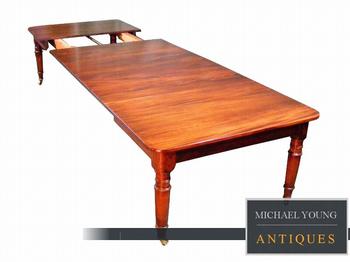featured item

quality pair of antique edwardian postal scales and weights Read more
What’s the State of the Victorian Furniture Market?
Posted by Bob Brooke on 10/05/2017
What’s the State of the Victorian Furniture Market?
Collecting antiques was formerly in the realm of the rich. But as Victorian furniture came of antiques age—over 100 years old—back in the 1960s, middle class and upper middle class people were able to afford to buy quality antique furniture for not much more than new pieces.
Before looking at the market for Victorian furniture, it’s important to distinguish between several groups of buyers. First, there are the true collectors who buy pieces for their style and who made them. Many of these people buy for investment. Buyers in this group would want to own not just any old parlor set but an elegant Rococo Revival one by John Henry Belter—the type usually scene in brothels in movies about the Old West.
Second, there’s the average person who likes old things. He or she prefers the elegant charm of an Renaissance Revival bedroom chamber suite to the stark modern mattress on a metal frame. These same people are also frequent guests to Victorian bed and breakfasts where they can immerse themselves in the romance of a bygone era.
Third, there are those to who live in new or relatively new “McMansions” and want furniture that they can show off to their friends and neighbors. These people often hire interior decorators to furnish their homes. If they do buy pieces themselves, they often do so at auctions where they bid up the price just because they can.
The market for Victorian furniture has a different effect for each of these buyers.
The number of furniture styles and sub-styles that fall under the broad category of Victoriana can seem endless. Also seemingly endless are the offerings in antique malls, and at auctions and shows. But are all these pieces selling?
At present, the market is mixed for Victorian furniture, depending on where you live and shop. Out West, there’s a scarcity of Victorian pieces while back East, where there’s a ready supply, collectors lean towards the big names like the Herter Brothers and Pottier & Stymus of New Work, and Kinibel Cabus, specialists in the Aesthetic style, and John Henry Belter, known for his original Rococo Revival carving techniques, all of which command high prices with traditional collectors. Middle-market collectors, however, generally select pieces for their affordability no matter where they live. People buying one to two pieces tend to buy what they like.
As with most antiques and collectibles, the desirability of' Victorian furniture is cyclical. What’s hot in one area of the country may be quite cool in another. In 1982, most antiques collectors—many of whom were bit antique themselves—looked unfavorably on Victorian furniture. If a piece originated after 1820, they didn't care about it. But today, serious collectors want the best.
These collectors seek out the American Empire pieces by Anthony Querelle of Philadelphia, the Rococo Revival work of John Belter, the Rococo Revival furniture of Meeks Brothers, and the high-style Aesthetic pieces by Herter Brothers.
For most collectors, 18th and early 19th-century furniture is too costly. Not many can afford to pay five and six figures for fine early pieces. But the antiques market still leans towards the high end. Younger people have been slow to start collecting antiques. Many caught in the upwardly mobile movement buy affordable furniture from IKEA and Wayfair.com—furniture they can easily dispose of when moving. In fact, they’d rather do that than settle for hand-me-downs from their parents or grandparents.
Those just starting out in antiques are looking at furniture from the 1920s and 1930s. And while those pieces aren’t really antiques, they’re simple and functional.
While Belter was great, especially for his superior workmanship, in today’s homes, even those of the wealthy, he’s a bit of a dinosaur. On the other hand, the late Empire style has a certain minimalist look or type of severity people are gravitating to now. It blends with modern homes.
There are several reasons why the market for Victorian furniture has suffered. There are demands on floor space in today’s homes. Because of this, it’s important that furniture be multi-functional. And while there’s still a market for ornate Victorian pieces, it has lessened dramatically. More homeowners of today’s development homes are hiring interior decorators because they don’t feel comfortable decorating and want to get it right.
Second, people don’t readily purchase Victorian furniture, no matter what its style, because they associate the Victorian design with clutter, and clutter today has negative connotations.
Third, the overwhelming number of styles and sub-styles that existed during Queen Victoria’s reign, running from 1837 to 1901, tend to overwhelm people. There were eight main styles, including Gothic Revival, Rococo Revival, Renaissance Revival, Neoclassic Revival, Eastlake, Arts and Crafts, Art Nouveau, Golden Oak, and Colonial Revival. And compared to 18th and early 19th-century American furniture, there's less information available about them.
Dealers, especially middle-market ones who carry Victorian pieces, are often unfamiliar with all the styles and frequently mislabel pieces. They look for heavily carved bedroom sets because they’re so unusual and so hard to find and for upholstered side chairs they prefer those with carvings on both the front and back. These bedroom sets can sell for 3,000 or more, but the number of buyers who can afford them and who have the space for them is small in comparison to other periods. The side chairs can sell from 300 to 700. Finer pieces by big-name cabinetmakers can usually be found only at auctions and exclusive shops.
With the market in its present state, it’s the best time to buy Victorian furniture.




